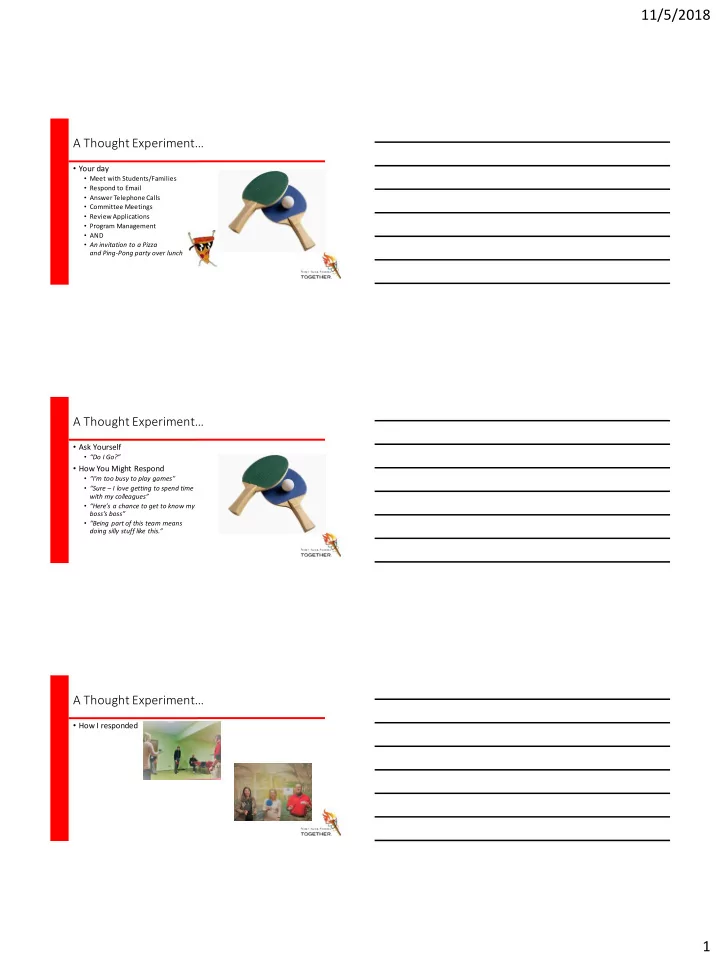

11/5/2018 A Thought Experiment… • Your day • Meet with Students/Families • Respond to Email • Answer Telephone Calls • Committee Meetings • Review Applications • Program Management • AND • An invitation to a Pizza and Ping-Pong party over lunch A Thought Experiment… • Ask Yourself • “Do I Go?” • How You Might Respond • “I’m too busy to play games” • “Sure – I love getting to spend time with my colleagues” • “Here’s a chance to get to know my boss’s boss” • “Being part of this team means doing silly stuff like this.” A Thought Experiment… • How I responded 1
11/5/2018 Introduction to the Four Frames Reframing Organizations By Lee G. Bolman and Terrence E. Deal Reframing Organizations • “The Curse of Cluelessness” • The Dilbert Principle: • “’The most ineffective workers are systematically moved to the place where they can do the least damage – management.’” • The problem to be solved • “We are hard pressed to manage organizations so that benefits regularly exceed costs.” • “ The big question: Why Should This Be?” The Curse of “Cluelessness” • “Cluelessness: defined • To become cocooned in imperfect worldviews such that one misread their circumstances and do not see other options. This Photoby Unknown Author is licensed under CC BY 2
11/5/2018 The Root of Cluelessness • “Clueless” Leaders • Possess inadequate mental models • Cannot fully assess the environment • Use only the most familiar neural pathways (i.e. “lazy” thinking) • “Artistic” Leaders • Able to “frame and reframe” experience • Find new ways to see things • Articulate their vision • Lead others to change perspective • “A primary cause of managerial failure is faulty thinking rooted in inadequate ideas.” What is a Frame? • Bolman and Deal define frames as: • Windows • Maps • Tools • Lenses • Orientations • Perspectives • As you “change frames” you change what you see Four Frames? • “To the man with a hammer, every problem looks like a nail.” • The Theory • There are 4 Frames • Most people use only 1 or 2 3
11/5/2018 The Four Frames The Four Frames • Structural • Human Resource • Political • Symbolic The Four Frames • How Managers Think • Limited view • Opt for rational solutions • Value certainty and control • Fearing ambiguity and “going with the flow” • Often rely on “One Right Answer” 4
11/5/2018 The Four Frames • How Managers Might Think • Holistic framework • A palette of options • Apply creativity, risk taking and playfulness • Not The Answer , but The Right Question • Passionate commitment to principle combined with flexibility Structural Frame • Assumptions • Goals and objectives • Division of labor and specialization • Control and coordination • Rationality • Designed for current environment • Problems result from structural deficiencies Structural Frame • Metaphor for Organization • Factory or Machine • Central Concepts • Rules, roles, goals, policies, technology, environment • Image of Leadership • Social architecture (e.g. hierarchy or organization chart) • Leadership Challenge • Attune structure to task, technology and environment 5
11/5/2018 Human Resource Frame • Assumptions • Organizations exist to serve human needs • Mutual/reciprocal need • “Fit” is key • Poor fit hurts both org and person • Good fit benefits both org and person Human Resource Frame • Metaphor for Organization • Family • Central Concepts • Needs, skills and relationships • Image of Leadership • Empowerment • Leadership Challenge • Align human and organizational needs Political Frame • Assumptions • Organizations are made up of coalitions of interest groups • Enduring differences exist among coalitions (values, interests and perceptions) • Scarce resources and differences lead to conflict • Power is the most important asset • Decisions emerge from bargaining, negotiation and jockeying for position 6
11/5/2018 Political Frame • Metaphor for Organization • Jungle • Central Concepts • Power, conflict, competition • Image of Leadership • Advocacy • Leadership Challenge • Set the agenda, establish power base Symbolic Frame • Assumptions • Meaning of events is most important • Events have multiple meanings • Symbols provide clarity, predictability, direction and hope amidst uncertainty and ambiguity • What is expressed is more important than what is produced • Shared values and beliefs creates a unifying organizational culture Symbolic Frame • Metaphor for Organization • Theatre, temple • Central Concepts • Culture, meaning, metaphor, ritual, ceremony, stories, heroes • Image of Leadership • Inspiration • Leadership Challenge • Create meaning, beauty, faith 7
11/5/2018 Putting the Four Frames into Action • Who Represents Which Frame? • Structural • Scarecrow • Human Resource • Tin Man • Political • Cowardly Lion • Symbolic • Dorothy • Story of a Quest Final Thought • Friend: “Paul, that doesn’t look much like a sunset” • Paul Cezanne: “Then you do not see sunsets as I see them.” Questions/Comments Robert Bode Director of Financial Aid and Veterans/Military Student Services University of Wisconsin River Falls robert.bode@uwrf.edu 8
Recommend
More recommend